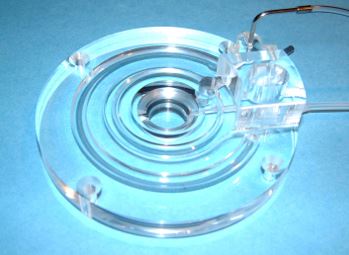KF Technology srl
Membrane Chamber MC
Membrane Chamber MC
Membrane Chamber MC
Submerged slices superfused for long-term viability, electrophysiology and optical studies
- Upright or inverted microscope access to a well perfused, perfectly flat and transparent in vitro slice preparation
- Slice viability increased beyond 16 hours as demonstrated with LFP recordings
- High mechanical stability, high flow rate and Bernoulli effect to optimise nutrient access for slices
- Quick replacement of membrane discs and chamber designed for easy cleaning
The MC is a new design of in vitro slice recording chamber (Hill & Greenfield 2010)
Brain slices are submerged on a completely flat, transparent semi-permeable membrane. This offers for the first time ideal conditions for inverted microscopy of in vitro preparations. The utilisation of a membrane with a high molecular weight cut-off ensures all nutrients and oxygen can flow freely for optimum perfusion. The design of the flow path is such that rates up to 20 ml / min can be used without inducing mechanical noise.
A further advantage is that the high speed flow of oxygenated aCSF directly underneath and across the semi-permeable membrane exerts a Bernoulli effect, resulting in a pressure difference between the upper and lower surfaces of the membrane
This in turn causes a significant movement of nutrients and oxygen downwards through the semipermeable membrane, increasing the availability to the slice especially on the underside and thereby surpassing passive slice perfusion techniques. The active flow downward through the membrane keeps the slice from floating and makes it mechanically stable. The transparent membrane offers ideal conditions for imaging through a glass coverslip window on the underside of the chamber with an inverted microscope whilst the upper chamber is exposed for microelectrode access. Alternatively there is sufficient access from above for upright microscopes to allow immersion objectives to be used and allow access with microelectrodes from the front and sides
Share


